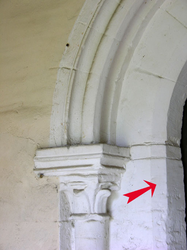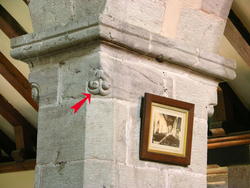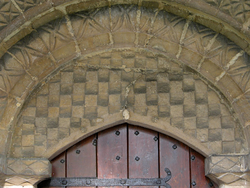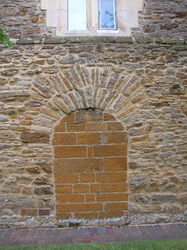
The Corpus of ROMANESQUE SCULPTURE in Britain & Ireland

Glossary

A moulding in the form of a rope, often applied to the neckings of capitals and the rims of fonts. Double-strand cable has two strands of different thicknesses twisted together.

An excellent limestone for masonry and sculpture, quarried in medieval times around Caen (Calvados) and along the River Orne, and exported to England in large quantities after 1066.

An arch with a raised lintel supported on curved springers with short vertical extensions.

A moulding found for example on the neckings of capitals, in which the roll is carved as a series of concave rings, like a cane bangle or bag handle.

The architectural member which surmounts a column and supports an arch. It often provides the visual transition between a round column or shaft below and a square impost block above, which in turn supports the springing of the arch.
A carved female figure used as a support; the male counterpart is an Atlas.
We know of no Romanesque examples in this country at present. Caryatids should not be confused with female column-figures, as illlustrated here, where a column acts as a support and the figure is attached to the froint of the column.

A concave moulding of a quarter-circular section.

Form of decoration consisting of a row of rings joined together by clasps or masks. Occasionally, as in a metal chain, they are linked one to another.

A diagonal surface made when the sharp edge or arris of a stone block is cut away, usually at an angle of 45 degrees to the other two surfaces. It is called a hollow chamfer when the surface created is concave.

A small carving, sometimes plain, sometimes ornamented, covering the transition between a chamfer and the main square faces of a block.

A chamfer applied to a base. This example has a plain chamfer.

The east end of a church where the altar is situated, usually reserved for the use of the clergy and choir.

Decorative patterning arranged in squares as on a chequerboard.

A form of three-dimensional architectural ornament consisting of zigzags formed by mouldings. The term 'zigzag' is itself reserved for the essentially two-dimensional form. Forms are varied and complex, so a separate Chevron Glossary has been supplied.

Simple geometric patterns (often saltire-in-square or star pattern) bevelled into a surface.

A chisel with a serrated edge used for finishing ashlar surfaces in the 12thc., which leaves distinctive parallel tooling marks.

The uppermost storey of the walls of an aisled church, pierced by windows.

A pier formed of a number of shafts with no angular elements separating them. See also compound pier.

Decoration involving sunk square or polygonal ornamental panels. In the Roman period it was used as a vault decoration, and in the Middle Ages a similar ornament is often produced by complex arrangements of chevron or lozenge ornament.

A column of small dimensions.

An upright structural member of round or polygonal section, consisting of a shaft crowned by a capital. See also engaged column. and pier

A carved figure attached to a column.

A pier with several shafts attached or detached, or half-shafts against the faces of it. compound piers have angular pieces separating the rolls, clustered piers do not.

In a doorway, window or arcading, an arch which does not rest on a column and capital, but is carried uninterrupted to the plinth.

A corbel is a projecting block of stone or timber to support a feature above. A row of corbels, often carved, supporting a parapet, stringcourse or the eaves of a roof is called a corbel table.

British Romanesque versions of the Roman Corinthian capital are usually very simplified, and can vary widely in form, but always have angle volutes and one or more rows of leaves on the faces.

A moulded ledge, projecting horizontally along the top of a building or feature such as a screen, etc.

Wall built with regular layers (courses) of ashlar.

Wall made with irregular stones or flints levelled up in courses.

A form of volute capital common around 1200. The angle volutes are elongated into hooked crockets, and there may be extra crockets projecting from the capital faces.

The central space at the junction of the nave, chancel and transepts of a cruciform church.

The tower over a crossing.

The vaulted chamber below the sanctuary or eastern arm of a church; usually at least partly underground. In monastic and secular buildings it is called an undercroft.

Normally described as a capital formed by the intersection of a cube and a sphere. It has flat semicircular faces below the abacus, and the triangular lower angles of the bell are all that remain of the spherical form. The semicircular faces are called shields. In variations of the cushion capital, the angles may be keeled or tucked. The shields and the bell may be decorated with carving.

A form of cushion capital where the faces are sculptured into a convex shape resembling billowing sails, with a pronounced seam at the corner.

Cusping is a repeated design of curved foils meeting at points (cusps).

A double-carved moulding of two types. Cyma recta has a concave curve above and a convex one below. Cyma reversa has a convex curve above and a concave below.




































